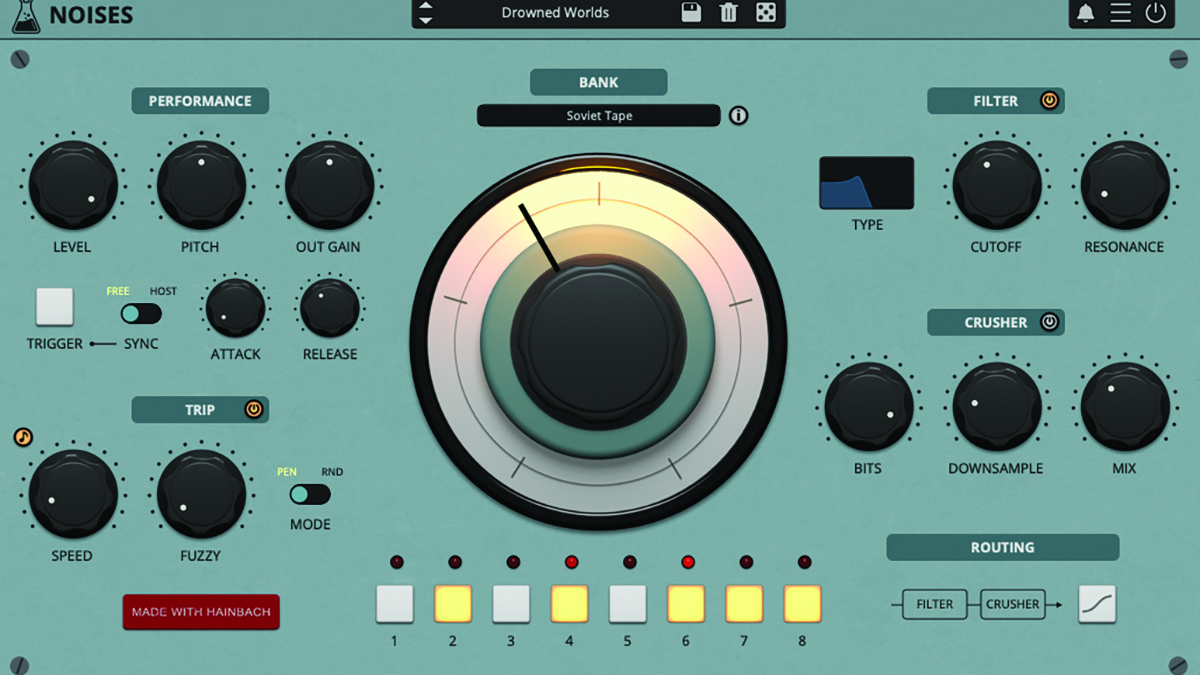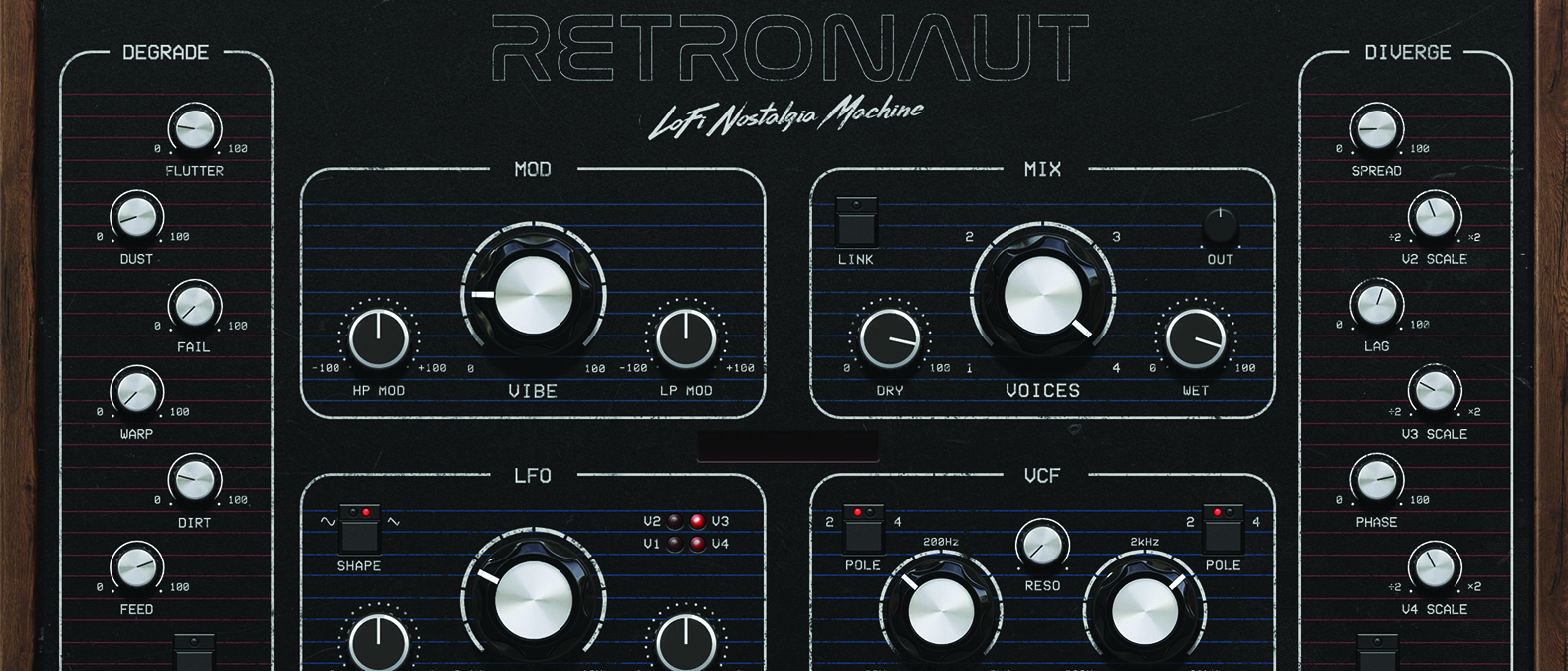MusicRadar Verdict
A gleaming new addition to your sound design arsenal, and an easy conduit for bringing in some mechanical grit
Pros
- +
A quality way of injecting that lo-fi sparkle (or lack of).
- +
Also a superb sound-design tool.
- +
Interface easy to get to grips with.
- +
Presets show Retronaut’s breadth.
Cons
- -
Hey, some people want to leave the past where it is!
MusicRadar's got your back
JMG Sound Retronaut: What is it?
A wise man once said, “the past is another country, they do things differently there”. In the world of music production, this sentiment rings exceptionally true.
The way that people used technology to not just record, but to shape their music was wildly different to what we have at our disposal on our hard drives today. As with the majority of vintage hardware, effects units suffered from the limitations of their format – crackle, hiss and signal degradation were rife.
While old-school gear might have technically been superseded, the mark it left on some of music’s most beloved moments has meant that people still seek to resurrect those long-lost ‘qualities’ and add them to their 21st-century tracks.
macOS (from 10.10 Yosemite to 12 Monterey, 64-bit) Intel/AMD/M1 processor with SSE2 support.
Windows 8/10/11 (64-bit) Intel/AMD processor with SSE2 support.
Buy at United Plugins
We’ve seen no short supply of such plugins in the lo-fi domain, but JMG Sound’s Retronaut might just be our new favourite. Whilst doing what it says on its aged tin ably, Retronaut’s deep filtering and sound-augmenting abilities mean it’s also a colourful option for shaping fresh, modern sounds.
On a surface level, Retronaut is a multi-voice vibrato and chorus plugin with additional lo-fi-leaning effects. Imparting the character of the old bucket brigade analogue delay chips, cassette tapes, the crackle of vinyl and the wow and flutter of tape, alongside the degradation of quality served by multi-generational transfers (or keeping the tape locked in a cupboard for a few decades).
JMG Sound Retronaut: Performance and verdict
The UI is pleasingly straightforward, with the four main control knobs – Modulation, Mix, LFO and VCF – sandwiched between the Degrade strip on the left and the Diverge strip on the right.

• AudioThing Noises
Noises lets you add vintage-flavoured experimental blasts with a satisfyingly deep control set.
• Waves Retro Fi
Waves’ old-school sound shaper has some deep abilities, and a weighty library of lo-fi tones.
The Mod section’s central Vibe dial tailors the rate of modulation for the base vibrato effect. The Mix control’s tentpole is the Voices control, which allows you to bring in more voices and develop the vibrato into a meaty chorus effect, the two-shaped (sine or triangle) LFO section sports controls for the Rate with independent high-pass/low-pass modulation. The VCF (filter) section is easily assignable to your external controllers, allowing for more performative movement-tailoring.
Want all the hottest music and gear news, reviews, deals, features and more, direct to your inbox? Sign up here.
One of the biggest joys of Retronaut comes from finding those sweet interlocking spots when these four primary controls turn your sound into something altogether cooler. Depending on what source you’re applying Retronaut to, the results can vary wildly.
We stuck an instance on a lightly saturated bass loop, and by decreasing the Vibe, cranking in some LFO, adding more voices, and applying the Spread control in the Diverge section, we were blown away at how alive this otherwise stilted riff became.
This Diverge section allows you to offset the four voices in a range of ways with the Spread control shifting the LFO phases across the stereo field, crafting the illusion of a far thicker sound. Other controls include Lag, which can act to make things a little bit queasier by introducing a time delay, and Phase which allows you to go in for more discreet warble-shaping.
Movement and colour
Further experiments with a dry acoustic drum loop and a (fittingly old-school) sequenced arp were similarly smile-inducing, with both sonic movement and tonal colour being lifted into a higher plane. Our arp started off fairly bleepy and neutral-sounding, but adding a few extra voices and some light modulation suddenly made it come to life.
As you can probably tell, our interest was seized by the frankly unexpected sound design-shaping potential here, but it has to be said, those lo-fi Degrade strip options are top-notch, from the click and noise of Dust and Dirt, to odd pitch drops and unexpected glitch-outs that the Fail dial introduces. There’s also the ability to switch your whole signal to mono, should you want to really take a leap back into the past.
Golden oldies
If you’d rather leap straight into what the plugin has to offer rather than get to grips with the tool’s specifics yourself, Retronaut has got a huge array of presets to get you started.
There are several conveniently arranged banks, nicely divided into labelled folders which span Chorus, Verb, Vibe, Redux and the alluringly-named Xtra. Within each, suggestive labels such as Night Moves, Fire Blanket and Old Times succinctly describe (or try to, at least) the aural effect that each will take upon your sound.
As with all signal-chain plugins, it’s fun to A/B each in turn, often hitting upon interesting characteristics which you can then use as a springboard.
Retronaut has you covered on the A/Bing front, with two switches in the upper left of the interface which can be swiftly flicked between when comparing two states of the plugin; that’s good for when you’re taking one of those preset sounds off into a new direction, and want to refer back to the source.
While the presets in themselves ably demonstrate the extreme ends of what the plugin can achieve, it’s really worth taking things into your own hands 99% of the time.
Verdict
We had great fun with Retronaut, and it’s likely to continue sitting on many of our signal chains as a speedy way to bulk up and characterise duller track elements.
While we’re not exactly lacking in vintage-angled software in our collection, the sound-enlivening qualities that JMG Sound’s latest bring to the table make it far more than just the nostalgia machine the company promised.
MusicRadar verdict: A gleaming new addition to your sound design arsenal, and an easy conduit for bringing in some mechanical grit.
JMG Sound Retronaut: The web says
"If lo‑fi is your thing, you’re in for a treat, and even if you think nostalgia ain’t what it used to be, Retronaut may well make you think again!"
Sound On Sound
JMG Sound Retronaut: Hands-on demos
United Plugins
Higher HZ
W. A. Production
Frankie Tedesco
JMG Sound Retronaut: Specifications
- macOS (from 10.10 Yosemite to 12 Monterey, 64-bit) Intel/AMD/M1 processor with SSE2 support.
- Windows 8/10/11 (64-bit) Intel/AMD processor with SSE2 support.
- Functions as a VST Plugin, an Audio Units Plugin, a VST 3 Plugin and an AAX Plugin.
- CONTACT: JMG Sound

I'm Andy, the Music-Making Ed here at MusicRadar. My work explores both the inner-workings of how music is made, and frequently digs into the history and development of popular music.
Previously the editor of Computer Music, my career has included editing MusicTech magazine and website and writing about music-making and listening for titles such as NME, Classic Pop, Audio Media International, Guitar.com and Uncut.
When I'm not writing about music, I'm making it. I release tracks under the name ALP.
